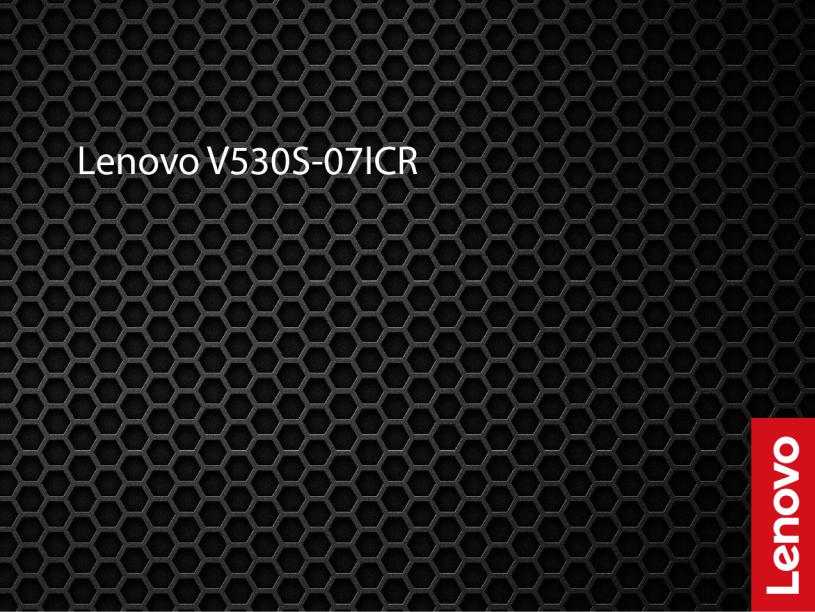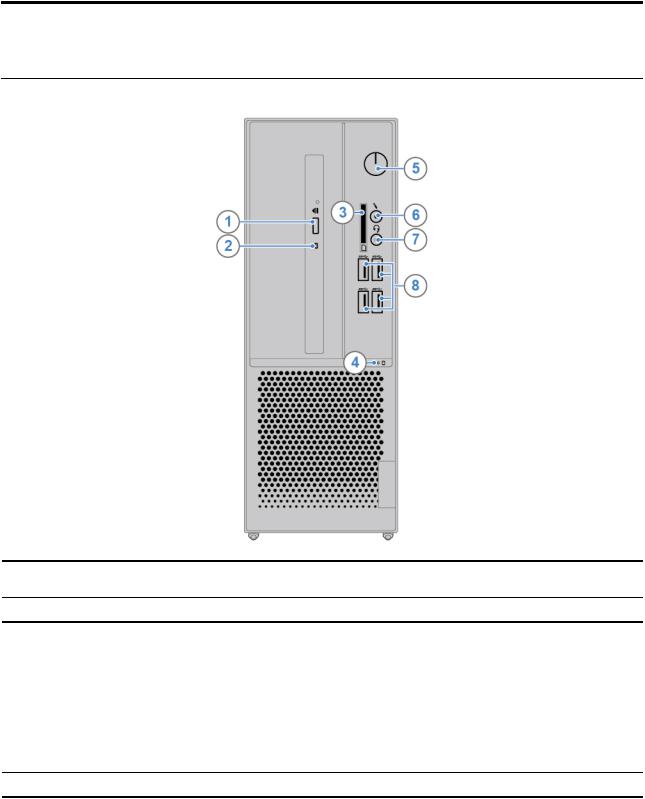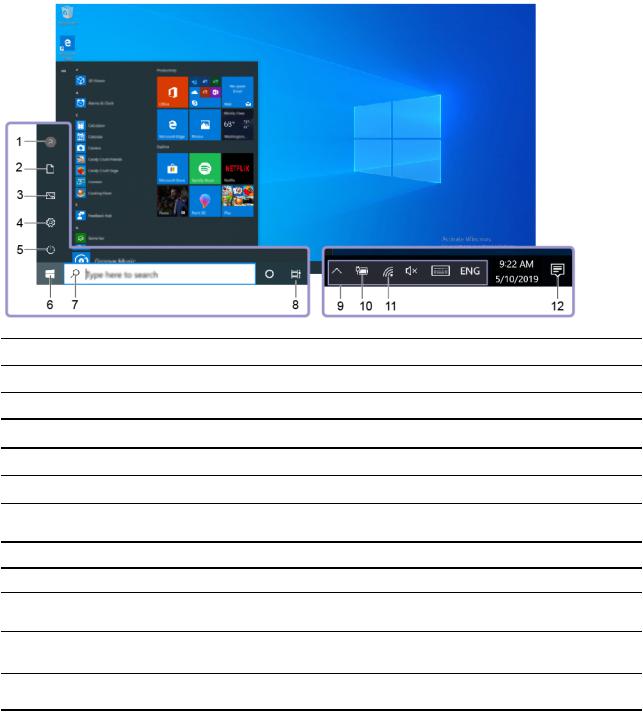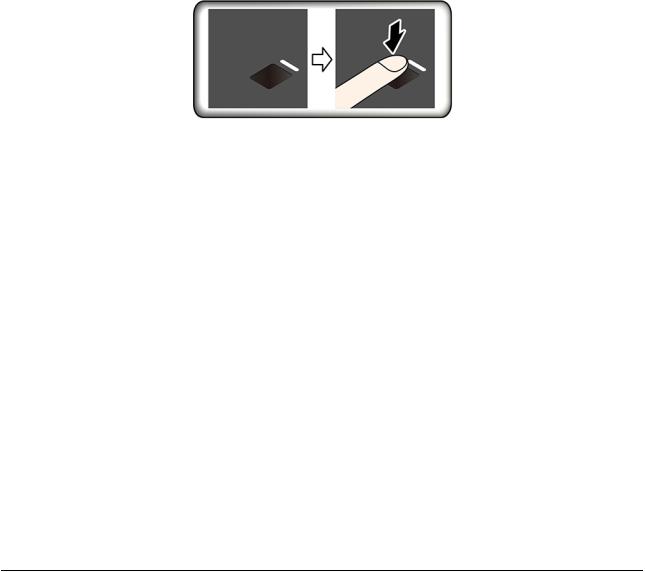Lenovo V530S-07ICR User Manual

Lenovo V530S-07ICR
User Guide
Read this first
Before using this documentation and the product it supports, ensure that you read and understand the following:
•Appendix A “Important safety information” on page 65
•Safety and Warranty Guide
•Setup Guide
First Edition (September 2019)
© Copyright Lenovo 2019.
LIMITED AND RESTRICTED RIGHTS NOTICE: If data or software is delivered pursuant to a General Services Administration “GSA” contract, use, reproduction, or disclosure is subject to restrictions set forth in Contract No. GS- 35F-05925.

Contents
About this documentation . . . . . . . .iii
Chapter 1. Meet your computer . . . . . 1
Front . . . . . . . . . . . . . . . . . . . . 1 Rear . . . . . . . . . . . . . . . . . . . . 3
System board . . . . . . . . . . |
. |
. . . . |
. |
5 |
Features and specifications . . . . . |
. |
. . . . |
. |
6 |
Statement on USB transfer rate . . |
. |
. . . . |
. |
7 |
Chapter 2. Get started with your computer . . . . . . . . . . . . . . . . . 9
Get started with Windows 10 . . . . . . . . . |
. |
9 |
Windows account . . . . . . . . . . . . |
. |
9 |
Windows user interface . . . . . . . . . . |
|
10 |
Connect to networks . . . . . . . . . . . . . |
|
11 |
Connect to the wired Ethernet . . . . . . . |
|
11 |
Connect to Wi-Fi networks (for selected |
|
|
models) . . . . . . . . . . . . . . . . |
|
11 |
Use Lenovo Vantage . . . . . . . . . . . . . |
|
11 |
Use multimedia . . . . . . . . . . . . . . . |
|
12 |
Use audio . . . . . . . . . . . . . . . |
|
12 |
Chapter 3. Explore your computer . . |
13 |
Manage power . . . . . . . . . . . . . . . |
13 |
Set power button behaviors . . . . . . . . |
13 |
Set the power plan . . . . . . . . . . . . |
13 |
Transfer data . . . . . . . . . . . . . . . . |
13 |
Connect to a Bluetooth-enabled device (for |
|
selected models) . . . . . . . . . . . . |
13 |
Use the optical drive (for selected models) . . |
14 |
Use a media card (for selected models) . . . . 14 |
|
Use a smart cable clip . . . . . . . . . . . . |
15 |
Purchase accessories . . . . . . . . . . . . |
15 |
Chapter 4. Secure your computer |
|
and information . . . . . . . . . . . . |
17 |
Lock the computer . . . . . . . . . . . . . |
17 |
Log in to your computer securely . . . . . . . . |
17 |
Use passwords . . . . . . . . . . . . . |
18 |
Use the fingerprint reader . . . . . . . . . |
18 |
Use software security solutions. . . . . . . . . |
19 |
Use firewalls . . . . . . . . . . . . . . |
19 |
Use antivirus programs . . . . . . . . . . |
20 |
Use computrace Agent software embedded in |
|
firmware (for selected models) . . . . . . . |
20 |
Use BIOS security solutions . . . . . . . . . . |
20 |
Erase all storage drive data . . . . . . . . |
20 |
Use the cover presence switch . . . . . . . |
21 |
Use Smart USB Protection. . . . . . . . . 21
Chapter 5. UEFI BIOS . . . . . . . . . |
23 |
What is UEFI BIOS. . . . . . . . . . . . . . |
23 |
Enter the BIOS menu. . . . . . . . . . . . . |
23 |
Navigate in the BIOS interface . . . . . . . . . |
23 |
Set the system date and time . . . . . . . . . |
23 |
Change the startup sequence . . . . . . . . . |
24 |
Enable or disable the configuration change |
|
detection feature . . . . . . . . . . . . . . |
24 |
Enable or disable the automatic power-on |
|
feature . . . . . . . . . . . . . . . . . . |
25 |
Enable or disable the ErP LPS compliance mode . . 25
Change BIOS settings before installing a new |
|
operating system . . . . . . . . . . . . . . |
25 |
Update UEFI BIOS. . . . . . . . . . . . . . |
26 |
Recover from a BIOS update failure . . . . . . . |
26 |
Clear CMOS . . . . . . . . . . . . . . . . |
27 |
Chapter 6. Troubleshooting, |
|
diagnostics, and recovery . . . . . . . |
29 |
Basic procedure for resolving computer |
|
problems . . . . . . . . . . . . . . . . . |
29 |
Troubleshooting . . . . . . . . . . . . . . |
29 |
Startup problems . . . . . . . . . . . . |
30 |
Audio problems . . . . . . . . . . . . . |
31 |
Network problems . . . . . . . . . . . . |
32 |
Performance problems . . . . . . . . . . |
34 |
Storage drive problems . . . . . . . . . . |
35 |
CD or DVD problems . . . . . . . . . . . |
35 |
Serial connector problems . . . . . . . . . |
36 |
USB device problems . . . . . . . . . . |
36 |
Software problems . . . . . . . . . . . . |
37 |
Diagnostics . . . . . . . . . . . . . . . . |
37 |
Lenovo diagnostic tools . . . . . . . . . . |
37 |
Recovery . . . . . . . . . . . . . . . . . |
37 |
Restore system files and settings to an earlier |
|
point . . . . . . . . . . . . . . . . . |
37 |
Restore your files from a backup . . . . . . |
37 |
Reset your computer . . . . . . . . . . . |
37 |
Use advanced options . . . . . . . . . . |
38 |
Windows automatic recovery. . . . . . . . |
38 |
Create and use a recovery USB device . . . . 38 |
|
Update the device driver . . . . . . . . . |
39 |
Chapter 7. CRU replacement . . . . . |
41 |
What are CRUs . . . . . . . . . . . . . . . |
41 |
Replace a CRU . . . . . . . . . . . . . . . |
41 |
© Copyright Lenovo 2019 |
i |
Computer cover . . . . . . . . . . . . . |
42 |
Front bezel . . . . . . . . . . . . . . . |
42 |
Optical drive . . . . . . . . . . . . . . |
43 |
Storage drive . . . . . . . . . . . . . . |
45 |
M.2 solid-state drive . . . . . . . . . . . |
49 |
Coin-cell battery. . . . . . . . . . . . . |
51 |
Memory module . . . . . . . . . . . . . |
53 |
PCI Express card . . . . . . . . . . . . |
55 |
Power supply assembly . . . . . . . . . . |
57 |
Complete the parts replacement . . . . . . |
58 |
Chapter 8. Help and support . . . . . |
61 |
Self-help resources . . . . . . . . . . . . . |
61 |
Call Lenovo . . . . . . . . . . . . . . . . |
62 |
Before you contact Lenovo . . . . . . . . |
62 |
Lenovo Customer Support Center . . . . . . |
62 |
Purchase additional services. . . . . . . . . . 63
Appendix A. Important safety information . . . . . . . . . . . . . . . 65
Appendix B. Accessibility and ergonomic information . . . . . . . . 79
Appendix C. Supplemental information about the Ubuntu operating
system . . . . . . . . . . . . . . . . . 83
Appendix D. Compliance
information . . . . . . . . . . . . . . . 85
Appendix E. Notices and
trademarks . . . . . . . . . . . . . . . 97
ii Lenovo V530S-07ICR User Guide

About this documentation
•Illustrations in this documentation might look different from your product.
•Depending on the model, some optional accessories, features, and software programs might not be available on your computer.
•Depending on the version of operating systems and programs, some user interface instructions might not be applicable to your computer.
•Documentation content is subject to change without notice. Lenovo makes constant improvements on the
documentation of your computer, including this User Guide To get the latest documentation, go to: |
. |
https://support.lenovo.com
•Microsoft® makes periodic feature changes to the Windows® operating system through Windows Update. As a result, some information in this documentation might become outdated. Refer to Microsoft resources for the latest information.
© Copyright Lenovo 2019 |
iii |
iv Lenovo V530S-07ICR User Guide

Chapter 1. Meet your computer
Front
1.Optical drive eject/close button*
2.Optical drive activity indicator*
3.SD-card slot*
4.Storage drive activity indicator
Eject or close the optical drive tray.
This indicator is on when the optical drive is in use.
Supported cards:
•Secure Digital (SD) card
•Secure Digital eXtended-Capacity (SDXC) USH-1 card
•Secure Digital High-Capacity (SDHC) USH-1 card
Note: Your computer does not support the content protection for recordable media (CPRM) feature for the SD card.
See “Use a media card (for selected models)” on page 14.
This indicator is on when the storage drive is in use.
© Copyright Lenovo 2019 |
1 |

5.Power button
6.Microphone connector
7.Headset connector
8.USB 3.1 connectors Gen 1 (4)
*for selected models
Press to turn on the computer. |
|
To turn off the computer, open the Start menu, click |
Power and then select |
Shut down |
. |
The indicator in the power button shows the system status of your computer.
•On: The computer is on.
•Off: The computer is off or in hibernation mode.
•Blinking: The computer is in sleep mode.
Connect a microphone.
Connect a headset or headphones to your computer.
Connect USB-compatible devices, such as a USB keyboard, USB mouse, USB storage device, or USB printer.
2 Lenovo V530S-07ICR User Guide

Rear
1. Audio line-out connector
2. HDMI 1.4 out connector
3.DisplayPort 1.2 out connector
4.VGA-out connector
5.USB 2.0 connectors (2)
6.USB 3.1 connectors Gen 1 (2)
7.Power cord connector
Send audio signals from the computer to external devices, such as powered stereo speakers, headphones, or multimedia keyboards. To connect a stereo system or other external recording device, connect a cable between the audio line-in connector of the device and the audio line-out connector of the computer.
Note: If your computer has both an audio line-out connector and a headset or headphone connector, always use the headset or headphone connector for earphones, headphones, or a headset. The headphone connector does not support headset microphones.
Send audio and video signals from the computer to another audio or video device, such as a high-performance™ monitor. For more information, see https:// www.hdmi.org/manufacturer/hdmi_1_4/index.aspx.
Send audio and video signals from the computer to another audio or video device, such as a high-performance monitor. For more information, see https:// www.vesa.org/wp-content/uploads/2010/12/DisplayPort-DevCon-Presentation-DP- 1.2-Dec-2010-rev-2b.pdf.
Send video signals from the computer to another video device, such as a monitor.
Connect USB-compatible devices, such as a USB keyboard, USB mouse, USB storage device, or USB printer.
Connect USB-compatible devices, such as a USB keyboard, USB mouse, USB storage device, or USB printer.
Connect the power cord to your computer for power supply.
Chapter 1. Meet your computer 3

8.Serial connector
9.Ethernet connector
10.Smart cable clip slots (3)
11.Padlock loop
12.Security-lock slot
13.Serial connector*
14.PCI-Express card area
*for selected models
Connect an external modem, a serial printer, or other devices that use a serial connector.
Connect to a local area network (LAN). When the green indicator is on, the computer is connected to a LAN. When the yellow indicator blinks, data is being transmitted.
Lock devices (such as the keyboard and the mouse) to your computer through a smart cable clip.
Lock the computer cover through a padlock.
Lock your computer to a desk, table, or other fixtures through a Kensington-style cable lock.
Connect an external modem, a serial printer, or other devices that use a serial connector.
Install PCI-Express cards into this area to improve the operating performance of the computer. Depending on the computer model, the connectors in this area vary.
4 Lenovo V530S-07ICR User Guide

System board
1 |
4-pin power connector |
2 |
Microprocessor socket |
||
3 |
Microprocessor fan connector |
4 |
Coin-cell battery |
||
5 |
Buzzer |
6 |
Memory slot (DIMM1) |
||
7 |
Memory slot (DIMM2) |
8 |
6-pin power connector |
||
9 |
Internal speaker connector |
10 |
Clear CMOS (Complementary Metal Oxide |
||
|
|
|
Semiconductor) / Recovery jumper |
||
11 |
Storage drive activity indicator connector |
12 |
Thermal sensor connector |
||
13 |
M.2 solid-state drive slot |
14 |
M.2 Wi-Fi card slot |
||
15 |
SATA connector (connecting to the storage drive) |
16 |
SATA power connector |
||
17 |
SATA connector (connecting to the optical drive) |
18 |
Card reader connector |
||
19 |
Serial (COM2) connector |
20 |
PCI Express x16 graphics card slot |
||
21 |
PCI Express x1 card slot |
22 |
Parallel connector |
||
Chapter 1. Meet your computer 5

Features and specifications
Dimensions
Weight (without the package)
Hardware configuration
Power supply
Electrical input
Microprocessor
Storage device
Video features
Audio features
•Width: 100.0 mm (3.9 inches)
•Height: 274.8 mm (10.8 inches)
•Depth: 304.4 mm (12.0 inches)
Maximum configuration as shipped: 4.2 kg (9.3 lb)
1.Right-click the Start button to open the Start context menu.
2.Click Device Manager Type the administrator password or provide confirmation if prompted.
•180-watt automatic voltage-sensing power supply
•Input voltage: From 100 V ac to 240 V ac
•Input frequency: 50/60 Hz
To view the microprocessor information of your computer, right-click the Start |
|
|
button and then click System |
. |
|
• |
3.5-inch storage drive* |
|
• |
2.5-inch storage drive* |
|
• |
M.2 solid-state drive* |
|
To know the storage drive capacity:
1.Right-click the Start button to open the Start context menu.
2.Click Disk Management
Note: The storage drive capacity indicated by the system is less than the nominal capacity.
•The integrated graphics card supports the following:
–DisplayPort 1.2 out connector
–HDMI 1.4 out connector
–VGA-out connector
•The optional discrete graphics card provides an enhanced video experience and extended capabilities.
•The integrated audio card supports the following:
–Audio line-out connector
–Headset connector
–Internal speaker*
–Microphone connector
•The optional discrete audio card provides an enhanced audio experience and extended capabilities.
6 Lenovo V530S-07ICR User Guide

|
• |
Card reader* |
|
• M.2 solid-state drive slot |
|
|
• |
Memory slots |
Expansion |
• |
Optical drive* |
|
• PCI Express x1 card slot |
|
|
• PCI Express x16 graphics card slot |
|
|
• |
Storage drive bay |
|
• |
Bluetooth* |
Network features |
• |
Ethernet LAN |
|
• |
Wireless LAN* |
* for selected models
Statement on USB transfer rate
Depending on many factors such as the processing capability of the host and peripheral devices, file attributes, and other factors related to system configuration and operating environments, the actual transfer rate using the various USB connectors on this device will vary and will be slower than the data rate listed below for each corresponding device.
USB device |
Data rate (Gbit/s) |
3.1 Gen 1 |
5 |
3.1 Gen 2 |
10 |
3.2 |
20 |
Chapter 1. Meet your computer 7
8 Lenovo V530S-07ICR User Guide

Chapter 2. Get started with your computer
Get started with Windows 10
Learn the basics of Windows 10 and start working with it right away. For more information about Windows 10, see the Windows help information.
Windows account
A user account is required to use the Windows operating system. It can either be a Windows user account or a Microsoft account.
Windows user account
When you start Windows for the first time, you are prompted to create a Windows user account. This first account you created is of the “Administrator” type. With an Administrator account, you can create additional user accounts or change account types by doing the following:
1.Open the Start menu and select Settings Accounts Family & other users
2.Follow the on-screen instructions.
Microsoft account
You can also log in to the Windows operating system with a Microsoft account.
To create a Microsoft account, go to the Microsoft sign-up page at https://signup.live.com and follow the onscreen instructions.
With a Microsoft account, you can:
•Enjoy one-time signing in if you are using other Microsoft services, such as OneDrive, Skype, and Outlook. com.
•Sync personalized settings across other Windows-based devices.
© Copyright Lenovo 2019 |
9 |

Windows user interface
1.Account 
2.Documents 
3.Pictures 
4.Settings 
5.Power 
6.Start button 
7.Windows Search 
8.Task View 
9.Windows notification area
10.Battery status icon
11.Network icon
12.Action center 
Open the Start menu
• Click the Start button.
Change account settings, lock the computer, or sign out from the current account.
Open the Documents folder, a default folder to save your received files.
Open the Pictures folder, a default folder to save your received pictures.
Launch Settings.
Shut down, restart, or put the computer into sleep mode.
Open the Start menu.
Type what you are looking for in the search box and get search results from your computer and the Web.
Display all opened apps and switch among them.
Display notifications and status of some features.
Display power status and change battery or power settings. When your computer is not connected to ac power, the icon changes to  .
.
Connect to an available wireless network and display the network status. When connected to a wired network, the icon changes to  .
.
Display the latest notifications from apps and provide quick access to some features.
• Press the Windows logo key on the keyboard.
Open the Start context menu
Right-click the Start button.
10 Lenovo V530S-07ICR User Guide

Access Control Panel
•Open the Start menu and click Windows System Control Panel.
•Use Windows Search.
Launch an app
•Open the Start menu and select the app you want to launch.
•Use Windows Search.
Connect to networks
Your computer helps you connect to the world through a wired or wireless network.
Connect to the wired Ethernet
Connect your computer to a local network through the Ethernet connector on your computer with an Ethernet cable.
Connect to Wi-Fi networks (for selected models)
1.Click the network icon in the Windows notification area. A list of available wireless networks is displayed.
2.Select a network available for connection. Provide required information, if needed.
Use Lenovo Vantage
The preinstalled Lenovo Vantage is a customized one-stop solution to help you maintain your computer with automated updates and fixes, configure hardware settings, and get personalized support.
Access Lenovo Vantage
Open the Start menu and click Lenovo Vantage. You also can type Lenovo Vantage in the search box.
To download the latest version of Lenovo Vantage, go to Microsoft Store and search by the app name.
Key features
Lenovo Vantage enables you to:
•Know the device status easily and customize device settings.
•Download and install UEFI BIOS, firmware and driver updates to keep your computer up-to-date.
•Monitor your computer health, and secure your computer against outside threats.
•Look up warranty status (online).
•Access User Guide and helpful articles.
Notes:
•The available features vary depending on the computer model.
•Lenovo Vantage makes periodic updates of the features to keep improving your experience with your computer. The description of features might be different from that on your actual user interface.
Chapter 2. Get started with your computer 11

Use multimedia
Use your computer for business or entertainment with the devices (such as a camera, a monitor, or speakers).
Use audio
To enhance the audio experience, connect speakers, headphones, or a headset to the audio connector.
Adjust the volume
1.Click the volume icon in the Windows notification area on the taskbar.
2.Follow the on-screen instructions to adjust the volume. Click the speaker icon to mute the audio.
Change the sound settings
1. Go to Control Panel and view by category.
2. Click Hardware and Sound Sound |
. |
3. Change the settings as you prefer.
12 Lenovo V530S-07ICR User Guide

Chapter 3. Explore your computer
Manage power
Use the information in this section to achieve the best balance between performance and power efficiency.
Set power button behaviors
You can define what the power button does according to your preference. For example, by pressing the power button, you can turn off the computer or put the computer to sleep or hibernation mode.
To change what the power button does:
1. Go to Control Panel and view by large icons or small icons.
2. Click Power Options Choose what the power buttons do |
. |
3. Change the settings as you prefer.
Set the power plan
For ENERGY STAR® compliant computers, the following power plan takes effect when your computers have been idle for a specified duration:
Table 1. Default power plan (when plugged into ac power)
•Turn off the display: After 10 minutes
•Put the computer to sleep: After 25 minutes
To awaken the computer from Sleep mode, press any key on your keyboard.
To reset the power plan to achieve the best balance between performance and power saving:
1. Go to Control Panel and view by large icons or small icons.
2. Click Power Options and then choose or customize a power plan of your preference. |
, |
Transfer data
Quickly share your files using the built-in Bluetooth technology among devices with the same features. You also can install a disc or media card to transfer data.
Connect to a Bluetooth-enabled device (for selected models)
You can connect all types of Bluetooth-enabled devices to your computer, such as a keyboard, a mouse, a smartphone, or speakers. To ensure that the connection is successful, place the devices 10 meters (33 feet), at most, from the computer.
1.Turn on Bluetooth on the computer.
a.Open the Start menu, and then click Settings Devices Bluetooth & other devices
b.Turn on the Bluetooth switch.
2.Click Add Bluetooth or other device Bluetooth
3.Select a Bluetooth device, and then follow the on-screen instructions.
© Copyright Lenovo 2019 |
13 |
Your Bluetooth device and computer will automatically connect the next time if the two devices are in range of each other with Bluetooth turned on. You can use Bluetooth for data transfer or remote control and communication.
Use the optical drive (for selected models)
If your computer has an optical drive, read the following information.
Know the type of your optical drive
1. Right-click the Start button to open the Start context menu.
2. Click Device Manager Type the administrator password or provide confirmation, if prompted. |
. |
Install or remove a disc
1.With the computer on, press the eject/close button on the optical drive. The tray slides out of the drive.
2.Insert a disc into the tray or remove a disc from the tray, and then press the eject/close button again to close the tray.
Note: If the tray does not slide out of the drive when you press the eject/close button, turn off the computer. Then, insert a straightened paper clip into the emergency-eject hole adjacent to the eject/close button. Use the emergency eject only in an emergency.
Record a disc
1. |
Insert a recordable disc into the optical drive that supports recording. |
|
2. |
Do one of the following: |
|
|
• Open the Start menu, and then click Settings Devices AutoPlay Select or turn on Use |
|
|
AutoPlay for all media and devices |
. |
|
• Open Windows Media Player. |
|
|
• Double-click the ISO file. |
|
3. |
Follow the on-screen instructions. |
|
Use a media card (for selected models)
If your computer has a SD-card slot, read the following information.
Install a media card
1.Locate the SD-card slot.
2.Ensure that the metal contacts on the card are facing the ones in the SD-card slot. Insert the card firmly into the SD-card slot until it is secured in place.
Remove a media card
Attention: Before removing a media card, eject the card from the Windows operating system first. Otherwise, data on the card might get corrupted or lost.
1.Click the triangular icon in the Windows notification area to show hidden icons. Then, right-click the
Safely Remove Hardware and Eject Media icon.
2.Select the corresponding item to eject the card from the Windows operating system.
3.Press the card and remove it from your computer. Store the card safely for future use.
14 Lenovo V530S-07ICR User Guide

Use a smart cable clip
Note: You can purchase a smart cable clip from Lenovo.
Lock devices (such as the keyboard and the mouse) to your computer through a smart cable clip.
1.Insert the clip 1 into the cable-lock slot 4 .
2.Pull the cables you want to lock through the dents in the smart cable clip.
3.Press the clip 2 into the cable-lock slot 3 until it snaps into position.
Purchase accessories
Lenovo has a number of hardware accessories and upgrades to help expand the capabilities of your computer. Options include memory modules, storage devices, network cards, power adapters, keyboards, mice, and more.
To shop at Lenovo, go to https://www.lenovo.com/accessories.
Chapter 3. Explore your computer 15
16 Lenovo V530S-07ICR User Guide

Chapter 4. Secure your computer and information
Lock the computer
Note: You are responsible for evaluating, selecting, and implementing the locking device and security feature. Lenovo makes no comments, judgments, or warranties about the function, quality, or performance of the locking device and security feature. You can purchase computer locks from Lenovo.
Padlock
Locking the computer cover through a padlock prevents unauthorized access to the inside of your computer.
Kensington-style cable lock
Lock your computer to a desk, table, or other fixtures through a Kensington-style cable lock.
Log in to your computer securely
This section provides secure ways to log in to your computer with a password, a fingerprint, or your face.
© Copyright Lenovo 2019 |
17 |
Use passwords
Password types
You can set the following passwords in UEFI (Unified Extensible Firmware Interface) BIOS (Basic Input/ Output System) to prevent unauthorized access to your computer. However, you are not prompted to enter any UEFI BIOS password when your computer resumes from sleep mode.
•Power-on password
When a power-on password is set, you are prompted to enter a valid password each time the computer is turned on. The computer cannot be used until the valid password is entered.
•Administrator password
Setting an administrator password deters unauthorized users from changing configuration settings. If you are responsible for maintaining the configuration settings of several computers, you might want to set an administrator password.
When an administrator password is set, you are prompted to enter a valid password each time you try to enter the BIOS menu.
If both the power-on password and administrator password are set, you can enter either password. However, you must use your administrator password to change any configuration settings.
•Hard disk password
Setting a hard disk password prevents unauthorized access to the data on the storage drive. When a hard disk password is set, you are prompted to enter a valid password each time you try to access the storage drive.
Notes:
–After you set a hard disk password, your data on the storage drive is protected even if the storage drive is removed from one computer and installed in another.
–If the hard disk password is forgotten, there is no way to reset the password or recover data from the storage drive.
Set, change, and remove a password
Before you start, print these instructions.
1. Restart the computer. When the logo screen is displayed, press F1 or Fn+F1.
2. Select Security |
. |
3.Depending on the password type, select Set Power-On Password Set Administrator Password or Hard Disk Password and press Enter.
4.Follow the on-screen instructions to set, change, or remove a password.
5.Press F10 or Fn+F10 to save the changes and exit.
You might want to record your password and store it in a safe place. Otherwise, if you forget the password, you have to take your computer to a Lenovo reseller or a marketing representative to have the password canceled. However, if you forget the hard disk password, Lenovo cannot reset your passwords or recover data from the storage drive.
Use the fingerprint reader
If you use a mouse with a fingerprint reader on it, fingerprint authentication can replace your passwords and enables you to log in to your computer simply and securely.
18 Lenovo V530S-07ICR User Guide

Enroll your fingerprints
Open the Start menu and then click Settings Accounts Sign-in options Then, follow the on-screen instructions to finish the enrollment.
During the enrollment, the fingerprints are associated with the Windows password automatically. It is recommended that you enroll more than one fingerprint in case of any injuries to your fingers.
Log in with your fingerprint
If the fingerprint reader indicator blinks in amber, the authentication is not successful.
Associate your fingerprints with your power-on password and hard disk password
1.Turn off and then turn on the computer.
2.When prompted, scan your finger on the fingerprint reader.
3.Enter your power-on password, hard disk password, or both as required. The connection is created.
When you start the computer again, you can use your fingerprints to log in to the computer without entering your Windows password, power-on password, or hard disk password. To change the settings, go to the BIOS menu.
Attention: If you always use your fingerprint to log in to the computer, you might forget your passwords. Write down your passwords, and keep them in a safe place.
•If you forget your power-on password, take your computer to a Lenovo-authorized servicer or a marketing representative to have the password canceled.
•If you forget your hard disk password, Lenovo cannot reset your password or recover data from the storage drive. Take your computer to a Lenovo-authorized servicer or a marketing representative to have the storage drive replaced. Proof of purchase is required, and a fee will be charged for parts and service.
Maintain the fingerprint reader
To ensure that the fingerprint reader works correctly, do not:
•Scratch the surface of the reader with anything hard.
•Use or touch the reader with a wet, dirty, wrinkled, or injured finger.
Use software security solutions
This section provides software solutions to secure your computer and information.
Use firewalls
A firewall can be hardware, software, or a combination of both depending on the level of security required. Firewalls work on a set of rules to determine which inbound and outbound connections are authorized. If the computer is preinstalled with a firewall program, it helps protect against computer Internet security threats,
Chapter 4. Secure your computer and information 19

unauthorized access, intrusions, and Internet attacks. It also protects your privacy. For more information about how to use the firewall program, refer to the help system of your firewall program.
To use firewalls:
1. Go to Control Panel and view by large icons or small icons.
2. Click Windows Defender Firewall and then follow the on-screen instructions. |
, |
Use antivirus programs
The computer is preinstalled with an antivirus program to help you guard against, detect, and eliminate viruses.
Lenovo provides a full version of antivirus software on the computer with a free 30-day subscription. After 30 days, you must renew the license to continue receiving the antivirus software updates.
Note: Virus definition files must be kept up-to-date to guard against new viruses.
For more information about how to use your antivirus software, refer to the help system of your antivirus software.
Use computrace Agent software embedded in firmware (for selected models)
The Computrace Agent software is an IT asset management and computer theft recovery solution. The software detects if changes have been made on the computer, such as hardware, software, or the computer call-in location. You might have to purchase a subscription to activate the Computrace Agent software.
Use BIOS security solutions
This section provides BIOS solutions to secure your computer and information.
Erase all storage drive data
It is recommended that you erase all storage drive data before recycling a storage drive or the computer.
To erase all storage drive data:
1.Set a hard disk password for the storage drive you will recycle. See “Use passwords” on page 18.
2.Restart the computer. When the logo screen is displayed, press F1 or Fn+F1.
3.Select Security Hard Disk Password Security Erase HDD Data and press Enter.
4.Select the storage drive you will recycle and press Enter.
5.A message is displayed, prompting you to confirm the operation. Select Yes and press Enter. The erasing process begins.
Note: During the erasing process, the power button and the keyboard are disabled.
6.After the erasing process is completed, a message is displayed, prompting you to reset the system.
Select Continue |
. |
Note: Depending on the storage drive capacity, the erasing process will take half an hour to three hours.
7.After the resetting process is completed, one of the following will happen:
•If the data on the system storage drive is erased, you will be prompted that no operating system is available.
•If the data on the non-system storage drive is erased, the computer restarts automatically.
20 Lenovo V530S-07ICR User Guide
Use the cover presence switch
The cover presence switch prevents the computer from logging in to the operating system when the computer cover is not properly installed or closed.
To enable the cover presence switch connector on the system board:
1.Restart the computer. When the logo screen is displayed, press F1 or Fn+F1.
2.Select Security Cover Tamper Detected and press Enter.
3.Select Enabled and press Enter.
4.Press F10 or Fn+F10 to save the changes and exit.
When the cover presence switch connector on the system board is enabled, if the cover presence switch detects that the computer cover is not correctly installed or closed, an error message will be displayed when you turn on the computer. To bypass the error message and log in to the operating system:
1.Properly install or close the computer cover.
2.Enter the BIOS menu, save and then exit.
Use Smart USB Protection
The Smart USB Protection function is a security function that helps prevent data from being copied from the computer to USB storage devices connected to the computer. You can set the Smart USB Protection function to one of the following modes:
•Disabled (default setting): You can use the USB storage devices without limitation.
•Read Only You cannot copy data from the computer to: the USB storage devices. However, you can access or modify data on the USB storage devices.
• No Access You cannot access the USB storage devices from the computer. |
: |
To configure the Smart USB Protection function:
1.Restart the computer. When the logo screen is displayed, press F1 or Fn+F1.
2.Select Security Smart USB Protection and press Enter.
3.Select the desired setting and press Enter.
4.Press F10 or Fn+F10 to save the changes and exit.
Chapter 4. Secure your computer and information 21
22 Lenovo V530S-07ICR User Guide

Chapter 5. UEFI BIOS
This chapter provides information about configuring and updating UEFI BIOS, and clearing CMOS.
What is UEFI BIOS
Note: The operating system settings might override any similar settings in UEFI BIOS.
UEFI BIOS is the first program that the computer runs when the computer is turned on. UEFI BIOS initializes the hardware components and loads the operating system and other programs. Your computer comes with a setup program with which you can change UEFI BIOS settings.
Enter the BIOS menu
Restart the computer. When the logo screen is displayed, press F1 or Fn+F1 to enter the BIOS menu.
Note: If you have set BIOS passwords, enter the correct passwords when prompted. You also can press Enter to skip the password prompt and enter the BIOS menu. However, you cannot change the system configurations that are protected by passwords.
Navigate in the BIOS interface
Attention: The default configurations are already optimized for you in boldface Improper change of the configurations might cause unexpected results.
Depending on your keyboard, you can navigate in the BIOS interface by pressing the following keys, or combinations of Fn and the following keys:
F1 or Fn+F1 |
Display the General Help screen. |
Esc or Fn+Esc |
Exit the submenu and return to the parent menu. |
↑↓ or Fn+ |
Locate↑↓an item. |
← → or Fn+ → |
Select←a tab. |
+/– or Fn++/– |
Change to a higher or lower value. |
Enter |
Enter the selected tab or submenu. |
F9 or Fn+F9 |
Restore to the default settings. |
F10 or Fn+F10 |
Save your configuration and exit. |
Set the system date and time
1.Restart the computer. When the logo screen is displayed, press F1 or Fn+F1.
2.Select Main System Time & Date and press Enter.
3.Set the system date and time as desired.
4.Press F10 or Fn+F10 to save the changes and exit.
© Copyright Lenovo 2019 |
23 |

Change the startup sequence
If the computer does not start up from a device as expected, you can change the startup device sequence permanently or select a temporary startup device.
Change the startup device sequence permanently
1.Depending on the type of the storage device, do one of the following:
•If the storage device is internal, go to step 2.
•If the storage device is a disc, ensure that the computer is on or turn on the computer. Then, insert the disc into the optical drive.
•If the storage device is an external device other than a disc, connect the storage device to the computer.
2.Restart the computer. When the logo screen is displayed, press F1 or Fn+F1.
3.Select Startup and then follow the on-screen instructions to change the startup sequence,.
4.Press F10 or Fn+F10 to save the changes and exit.
Select a temporary startup device
Note: Not all discs and storage drives are bootable.
1.Depending on the type of the storage device, do one of the following:
•If the storage device is internal, go to step 2.
•If the storage device is a disc, ensure that the computer is on or turn on the computer. Then, insert the disc into the optical drive.
•If the storage device is an external device other than a disc, connect the storage device to the computer.
2.Restart the computer. When the logo screen is displayed, press F12 or Fn+F12.
3.Select the storage device as desired and press Enter.
If you want to change the startup device sequence permanently, select Enter Setup on Startup Device Menu and press Enter to enter the BIOS menu.
Enable or disable the configuration change detection feature
If you enable configuration change detection, when the POST detects configuration changes of some hardware devices (such as storage drives or memory modules), an error message will be displayed when you turn on the computer.
To enable or disable the configuration change detection feature:
1.Restart the computer. When the logo screen is displayed, press F1 or Fn+F1.
2.Select Security Configuration Change Detection and press Enter.
3.Enable or disable the feature as desired.
4.Press F10 or Fn+F10 to save the changes and exit.
To bypass the error message and log in to the operating system, press F2 or Fn+F2. To clear the error message, enter the BIOS menu, save and then exit.
24 Lenovo V530S-07ICR User Guide
